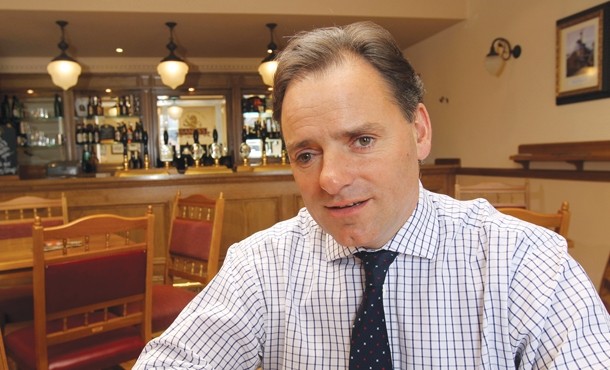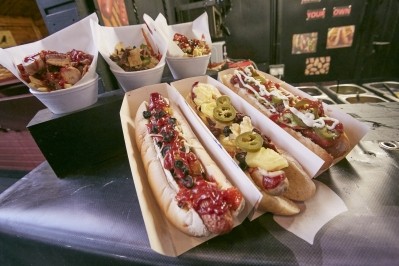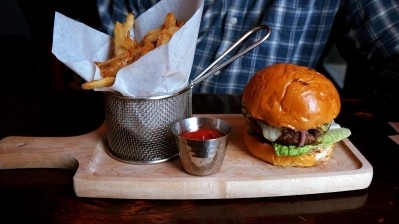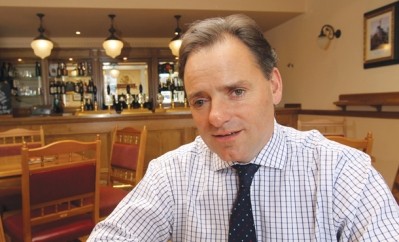City news
Marston’s: New builds, burrito bars and casual dining

Findlay discussed the ways the company has adapted its strategy to cope with the rapid rise of casual dining and explained why he thinks the problem of investment outstripping demand is even more out of control than in the late 90s.
The pair also talked about trading in the first few weeks of the year, new innovations including the trial of a burrito bar.
Findlay talked about the likely impact of the Apprenticeship Levy and the company’s desire to use training incentives to rollout the National Living Wage to all staff. M&C also reveals more on the company’s first new build franchise pub and its first new build Tavern.
First 8 weeks
Marston’s announced in its end of year update last month that it would no longer issue seven-week trading indications in its preliminary results. However, Andrea hinted that Marston’s had not seen the slide Mitchells & Butlers admitted to when it updated the market earlier this week.
Andrea said: “We took the decision not to update on that period because frankly October and November don’t contribute a lot to Q1. December accounts for twice the sales of October and November combined.
“We have used the words – we have had a good start to the year, in line with expectations. Our like-for-likes forecast is set around a couple of percent of growth. So, what you can infer from that is that the number is up not down and probably north of 1%.”
On the impact of the Rugby World Cup, Andrea said: “We describe ourselves as fairly sports agnostic so we were in a position where our wet-led pubs benefitted, our food-led pubs didn’t and they pretty much cancelled each other out.
Estate mix
The current 1,597-strong estate (down from 1,689 in 2014 and 2,050 in 2013) is made up of 397 managed sites in the Destination & Premium arm (2014: 372; 2013: 349) ; 859 franchised and managed pubs in its Taverns division (2014: 974; 2013: 1,316) and 341 leased pubs (2014: 343; 2013: 385).
Findlay highlighted the difference in profit mix over a three year period. In 2012 average pub profit was £73,000 with Taverns making up 47% of the profit mix; Destination & Premium 36% and Leased 17%. The 2015 picture shows a 37% rise in average profit per pub to £100,000 with Destination & Premium leading the profit mix with 51%; Taverns 34% and Leased 15%.
Marston’s has set its target at having 85% of its estate franchised and managed.
First franchised new build
The company is currently on site for its first franchised new build - Teal Farm, Washington, Tyne and Wear.
The pub, which is on a new build housing development, will be run by a multiple franchisee, who currently operates another three franchises turning over c£25k a week.
Findlay said: “That demonstrates our confidence in where franchise has got to in our business and what its potential might be.
This particular site looked to be very much a pub with community values as opposed to a simple destination food-led pub. When you have got that local involvement you want a licensee that’s involved with the community, who can get involved with local teams and entertainment and things the community likes. Historically that was always the strength of the tenanted and leased model and we think we can get the same input with the franchise agreement.
“At this point, this is the first we’ve done so we will monitor how this goes.
“What I think is likely is that we will do more conversions of some Destination pubs into franchise.”
Pitcher & Piano
The 20-strong Pitcher & Piano brand will also get its first new build with expectation that it will come online at the end of 2016 or early 2017.
On the reasoning behind the move, Findlay said: “We have got a good brand there. It’s generally more wet-led than Revere so it suits certain environments more than others. This is all about individual site locations and where we can find.”
Leased
The Leased estate recorded like-for-like profit growth of 4% with a 2.5% rental growth and average EBITDA at £75,000. Marston’s said moderate capital investment was being reintroduced and that licensee stability stood at 90%.
Findlay said: “Like-for-like profit growth of 4% is a good performance when you look at what is going on in the wider market and is demonstrates the quality of assets. We do think that franchised is the model for community pubs but we also think that the leased model is still a very good model for those kinds of pubs with more potential for food.”
New concepts
Findlay said the company had recorded positive results from its innovation across food and drink throughout 2015. He said the Pizza Kitchen concept was now in 40 sites and Revere’s Burger and Pizza offer had featured in the last two openings.
He said the company was trialling a Burrito Bar concept in “a handful” of pubs.
Andrea said: “It’s very much about responding to changing consumer demands prompted by casual dining offers. It’s carvery by day and burrito bar by night, attracting a younger food audience.
Findlay confirmed that the company’s all-day community pub concept Generous George would be at 10 sites by the end of the year, as reported by M&C earlier this month.
He said the Ebb & Flow café/bar concept “remains in trial mode at the moment” with four sites.
Casual dining
Findlay said the company had adapted its approach to deal with the increasing competition from casual dining.
He said: “There is an issue with overinvestment of some areas of the eating out market – what we call high footfall hotspots. We have been talking about that in terms of the impact on London for some time now but we are now seeing the same kind of thing in other major UK cities. It’s a really important point from a Marston’s point of view that our focus is away from those hotspots. We have deliberately kept our focus on what you might call secondary towns – market towns, where we are less likely to come up against branded casual dining operators.
“If you look at the places we have targeted recently - Aberystwyth, Dagenham, Dunbar, these are places where we can justifiably keep to our claim of being the best pub for miles around. In those areas the population stats just don’t work for those branded operators so they stay away.
“We looked at West Quay Southampton, where we would have been alongside an array of very good casual dining operators and paying a high rent. We looked at it but we walked away. However, we have bought the former town hall in Knutsford (to bring into the Revere segment), which is a standout iconic building. That’s a good example of what we consider a good investment.”
On the impact of aggressive expansion by casual dining operators, Findlay said: “I think there is a problem in terms of there being more investment going in than there is demand. What it feels like is worse than the over-investment that happened in high street bars in the back end of the 90s. It’s much wider spread than it was back then. You are talking about the sustainability of these towns and that’s why we don’t want to get caught up in that.
“Casual dining has certainly had an impact on what people expect when they go out to eat and what that has meant for us is that we have taken certain keys from casual dining and incorporated those into our offer. For example, we have had a big push in oven-baked pizzas in our pubs, rotisserie chicken, so it has a more branded look and feel about it.”
However, Andrea stressed that Marston’s pubs could ward off competition, citing the example of The Lost and Found in the centre of Birmingham. He said despite the opening of a Cosy Club opposite the site, New Trading Company’s Botanist around the corner and the nearby Grand Central development, with a host of casual dining operators, the site had maintained its sales.
Andrea said: “If your offer is good enough, the building is good enough and the proposition is right then people will stay loyal to you.
“When the new toy comes into town you will always be impacted because people will go and visit and will want to compare you. If you are better, then they will come back to you. We have had competitors open up near us on retail parks and the numbers have gone down for the first couple of months and then they have gone right back up again.
“Part of that is because we are a pub and we have a pub name. It’s not the same box with a badge above the door – in that circumstance you are purely reliant on the brand of the pub. Our brand is the pub and it’s one that the British public is very attached to.”
Findlay said that competition from pubs had “eased somewhat compared to two or three years ago”.
He added: “Our principal competitors there have tended to be M&B and Greene King and there seems to be less activity from those two at present than there was two or three years ago.”
On the potential for a threat from Enterprise Inns’ managed aspirations, Findlay said: “They are taking converting 800 pubs over the next four or five years so it would be wrong to say it will have no impact but they are already pubs so it’s not the case that we are seeing new pubs coming into the market.”
National Living Wage
Findlay reiterated that the company had been expecting the minimum wage to close the gap on the living wage and had factored that in to long-term forecasts. He said the increase to £9.20 an hour was a difference of about £2m a year for Marston’s.
On how the company will implement the NLW, Findlay said: “We are not looking to discriminate against people on the basis of whether they are over or under 25. We will look to make up the difference for everyone else as soon as possible. That will be by bringing them onto development programmes, training so that we can expect more from them and pay them accordingly.”
Apprenticeship levy
On the apprenticeship levy, which was announced in the Autumn Statement, Findlay said: “It’s not entirely clear yet how it will affect us because we haven’t analysed it fully but there will be some costs associated with it, which is a bit bizarre in the context of the Government trying to encourage companies to offer apprenticeships. We have employees who are apprentices and some who are.” He said the company currently has 14,000 employees in total, of which a few hundred are apprentices.
On other announcements in the Autumn Statement, Findlay said he was pleased to see an extension of the small business rates relief and said the reversal of tax credits was positive for consumer spending levels.
EPOS
Marston’s is working with PCMS, which has previously worked with John Lewis and Marks & Spencers, on the rollout of a new EPOS system from the middle of next year, which will involve a c£10m outlay.
Andrea said: “We are getting something that draws on a broader retail learning base. It’s not just about point and click it’s about improving the customer journey and mining the data we collect.
“We will have a better understanding of how customers are behaving. Bear in mind that we have our own telecoms system so if customers are logging on to Marston’s in any shape or form we can actually look at how they move around a pub and how they use the pub. That listening technology is just getting smarter and smarter. You are able to talk to our customers and listen to them in a different way.
“Digital’s role in our sector has so far been largely about talking and offering discounts. If we want to extract real value from digital we have got to use it to listen harder to what people are saying.
“We want to get to a point where on a Monday a manager has a way of seeing what the customers said about the pub last week and this was where they were talking about you. For one pub all the engagement might be on Facebook, for another it might be Instagram and in 10 years’ time it might be something completely different.”
Brewing
Findlay said Thwaites volumes had continued to rise since the acquisition earlier this year.
He said the portfolio had evolved over the past decade to reflect changing consumer demands. While in 2005 the premium ale mix made up 40% of the whole, it is now 70%. The take home element has risen from 30% to 55% and external sales as a percentage of total ale has gone up from 70% to 80% in the last ten years.
On the potential for further brand acquisitions, Findlay said: “I’m not going to say we’ll look for more acquisitions within the next year but we’re certainly interested in the potential for making more acquisitions at the right time, at the right price for the right brands.”







